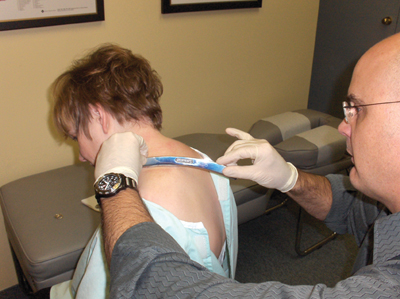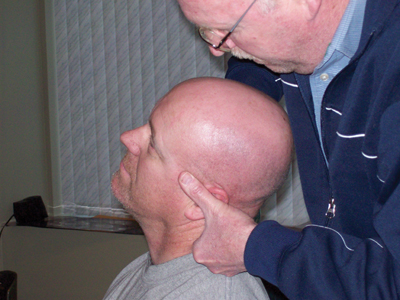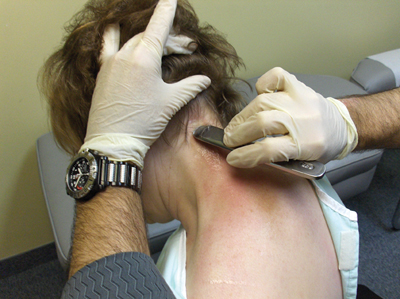
Technique Toolbox: Migraine headaches
By John Minardi
Features Clinical TechniquesGonstead and Graston techniques
Migraine headaches are a condition that chiropractors face daily. Every practising chiropractor has witnessed the debilitating effects migraines can have on their patients, and each chiropractor does everything in his/her power to alleviate the symptoms, as well as improve the patient’s overall health and well-being.
 |
|
| Figure 1: Graston general scan of the posterior cervical muscles using a GT5.
|
A special thank-you goes to Dr. Mark Prii of Surrey, British Columbia, and Dr. Jay Burness of Oakville, Ontario, for their tremendous contributions to this article.
Migraine headaches are a condition that chiropractors face daily. Every practising chiropractor has witnessed the debilitating effects migraines can have on their patients, and each chiropractor does everything in his/her power to alleviate the symptoms, as well as improve the patient’s overall health and well-being.
Research shows that chiropractic care can have a positive impact on migraines.1,2,3,4,5 The literature indicates that chiropractic care results in statistically significant decreases in migraine frequency and duration, while reducing its disabling effects and the patient’s use of medication. 1,2,3The research also suggests that cervical spine adjustments have a similar effect to common first line prophylactic prescription medications.4 Furthermore, combining chiropractic adjustments with active or passive soft tissue treatment improves a patient’s strength, flexibility and range of motion, while decreasing the frequency and duration of migraines.4,5
So, which specific technique protocols can help with migraines? In this edition of Technique Toolbox, I will discuss two chiropractic treatment procedures that can be combined to combat migraines, and get our patients back on the road to recovery. Before we begin, let us assume that a proper initial examination has taken place, that no contraindications are present, and that this is an appropriate chiropractic case.
 |
|
| Figure 2: Gonstead seated cervical adjustment for a C2-PLS-inf subluxation.
|
|
 |
|
| Figure 3: Treatment of fibrotic areas using a GT4 or GT3.
|
Gonstead Technique
The Gonstead System and procedures are the result of clinical research by Dr. C.S. Gonstead. The Gonstead chiropractor conducts a thorough analysis of a patient’s spine using five criteria to detect vertebral subluxations: case history, static palpation, motion palpation, instrumentation and full spine X-ray analysis. It is important to remember that each patient is different, and therefore will have different vertebral findings associated with their individual migraines. Once these vertebral subluxations, with their specific direction of movements, are detected, proper correction can take place.
Graston Technique
In combination with the Gonstead adjustment, I would recommend using the Graston technique. Although relatively new to chiropractic, Graston has proven to be an excellent tool to address the soft tissue components associated with vertebral subluxations. This technique utilizes uniquely shaped stainless steel instruments to detect and correct soft tissue abnormalities. Similar to any chiropractic technique, no strict headache protocol is ascribed to the Graston technique. However, the involvement of the cervical musculature in many headache cases does suggest an application in this area to be clinically useful, and can work in association with chiropractic adjustments.
Soft tissue evaluation must include the sternocleidomastoid, splenius and semi-spinalis capitis, trapezius, levator scapulae, and occipitalis muscles bilaterally.
Analysis of Graston technique: (Figure 1)
- A general scan of the posterior cervical musculature can be performed with GT5, a curved instrument which conforms well to the posterior contour of the neck.
- A small amount of lubricating cream is applied to the skin. The instrument is then dragged caudal, or cephalad, along the course of the muscle being tested.
- The doctor should position the instrument such that the bevelled edge of the tool leads. The normal texture of the muscle should be smooth. Areas of fibrotic change are felt as “rough spots” in the muscle.
- The stainless steel instruments transmit vibration readily and the effect is a “magnification” over the roughened areas.
- These areas can be further localized and the muscles examined more deeply by switching to another instrument, such as GT4 or GT3, which has a convex or sharper contour.
Case Study
Research indicates that chiropractic adjustments in the cervical area produce positive effects on migraines. As an example to illustrate this, we will focus on a common Gonstead finding and correction in this area. A typical listing in a migraine sufferer, found through the five criteria mentioned earlier, is a C2-PLS-inf. This indicates that C2 (spinous process reference point) has subluxated posterior, left, and superior, and that the disc is wedged inferior.
To correct this subluxation using the Gonstead technique: (Figure 2)
- Patient – Seated.
- Doctor – Standing behind the patient.
- Contact – PIP contact on the right bifurcation of the C2 spinous process.
LOD: anterior (to correct the posteriority), right (to correct the left misalignment) and inferior (to correct the superiority). Note that all three directional components of the correction are done simultaneously in one thrust. This will correct the abnormal biomechanics of the subluxated vertebra, as well as the disc wedging.
Treatment with Graston technique: (Figure 3)
- Once the involved areas have been identified, treatment consists of breaking up the areas of fibrosis, by running the proper instrument in multiple directions over the rough spots, until a smooth muscle texture is achieved.
- Redness and discomfort over the affected area during treatment is normal, and will subside.
Currently, there is no clear order in which to perform adjustments or soft tissue work. I prefer to adjust the subluxated segments first, to clear any abnormal biomechanics and abhorrent neurological input from the subluxated vertebra. Following the adjustments, I like to perform soft tissue work to clear up any fibrotic areas that may be present. However, if a practitioner prefers to do soft tissue treatment prior to adjusting, he/she can certainly do that.
Final Comments
My intent behind writing Technique Toolbox is to shed light on the plethora of chiropractic techniques available to us as a profession. It is also my goal to show that these techniques can be used in combination with one another to achieve maximum results for the patient – as displayed, in this case, with migraines. Obviously, I have only scratched the surface with these techniques. If you would like to learn more about the techniques discussed in this edition, please visit: www.gonsteadseminar.com and www.grastontechnique.com.
Until next time… adjust with confidence.
If you have any suggestions, or have a technique that you would like featured in a future edition of Technique Toolbox, please contact me at johnminardi@hotmail.com .
For article with references, please visit www.cndoctor.ca.
Print this page